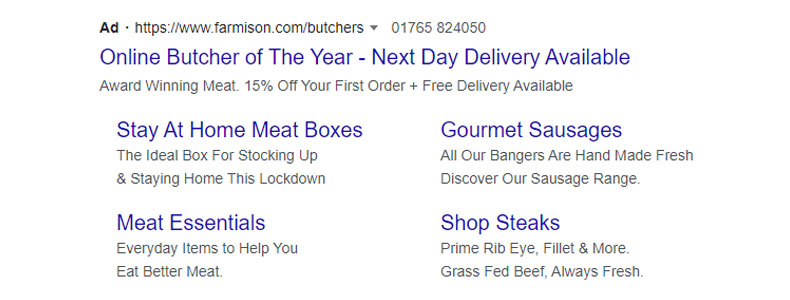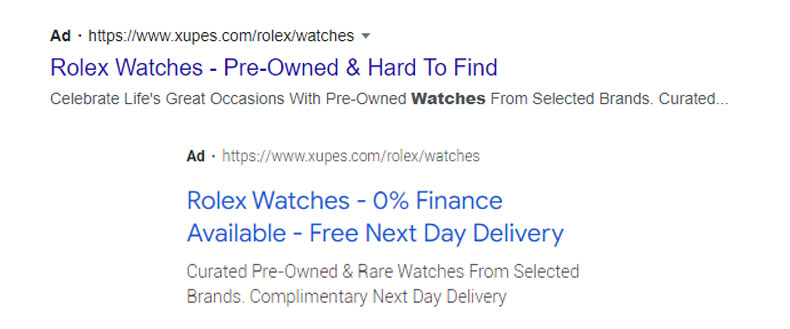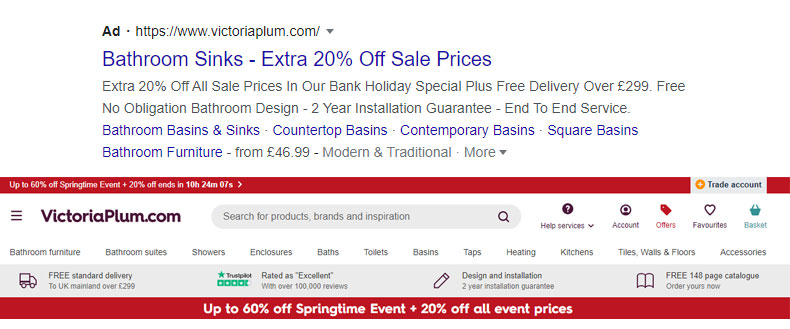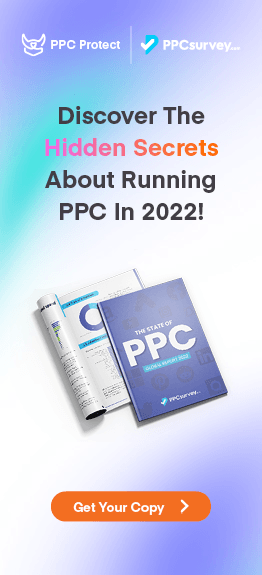Even veteran marketers sometimes find crafting PPC ad copy a challenge. There’s so much to say and not much space (or characters) to say it in. However, the stakes are high as every unconverted impression and click are wasted opportunities.
To get the most out of your ads, we’ve put together 12 PPC ad copy tips that are essential for marketers who want to take their ad copy to the next level. And they’re also helpful for beginners looking to make the best possible start. Aimed primarily at Google Ads, don’t let that put you off, these tips are relevant to all PPC platforms.
Get the most out of your PPC ads, improve your CTR and sales with these actionable PPC ad copy tips.
PPC Ad Copy Tips
1. Pre-qualify Clicks
When every click costs tens of dollars, discouraging timewasters and pre-qualifying clicks is a valuable strategy. And it’s even more important if you have a premium-priced product or service.
Including dollar amounts in your ad copy eliminates non-serious window shoppers straight away. It also means there are no nasty surprises when visitors are taken to a landing page with a high dollar price. Only those willing to pay the premium price will use the pre-qualify click.

2. Use Ad Extensions
Ad extensions are a proven way to increase ad relevance, engagement, and ultimately conversions.
The beauty of ad extensions is that they enable you to manually or automatically set different features on your ads. This gives you more room to work with and also helps you stand out from the competition.

Popular ad extensions include the following:
- Location extension – this ad extension displays your company’s physical address. It’s a valuable feature for businesses providing local services or those depending on foot traffic
- Promotion extension – highlights your company’s current sales promotions
- Callout extension – showcases your products’ features and selling points.
There are several other ad extension options available. Check out our blog on the best Google ad extensions for more detail.
3. Address Potential Objections
Use this technique to head off any potential objections from customers from the get-go. Think about reasons your customers may have for not making a purchase, then address them in your ad copy before they have chance to dwell on them.

Here’s a good example from a food delivery company. In these COVID times, contactless delivery is a priority for many consumers. A food delivery business that highlights contact-free delivery may get more clicks than competitors that fail to do so.
If you’re not sure what objections your customers may have, then talk to your sales team or conduct customer surveys.
4. Establish Authority & Credibility
Developing trust and brand authority is a crucial part of the buying cycle. Use your PPC ad copy to establish your credentials. Got a 5-star rating on Google reviews or Trustpilot? Make sure you highlight it in your ad copy.

Other ways to establish your credibility include:
- Number of years you’ve been in business
- Industry awards
- Using trademarks™ or registrations®
- Customer statistics
This kind of social proof is highly persuasive for consumers. It increases their confidence and helps to reduce any sense of risk they may have with clicking on your ad.
5. Include Figures In Headlines
Numbers in your ad’s headline are a great way to grab attention. They take up less space than words, and they are specific, providing substance to your ad.
It could be your product price, customer statistics, or a special offer.

However, not all numbers are equal. Make sure you include exact figures only. Consumers tend to have more faith in exact numbers rather than rounded ones. Therefore, you’re more likely to have a better click-through rate (CTR) if your special offer price is $99.99 rather than $100.
6. Differentiate Yourself
Setting yourself apart from the competition is vital to ad performance. You need to briefly answer the question that every potential customer has in the back of their minds: Why should I choose your company instead of the others? It’s all about highlighting your unique selling point and what makes you special.

It could be your personalized customer service, your long-established brand name, or your time-saving solution. Generally, it’s best to focus on the benefits and the added value you offer. Put yourself in the shoes of a potential customer and think about the difference your product or service will bring to their lives.
7. Use FOMO
The fear of missing out (FOMO) is a powerful motivator in the buying cycle. No one likes to feel as though they are missing out on an opportunity so introducing an element of urgency in your ad copy will make your offer harder to refuse.
Time-limited discounts, end-of-season sales, or buy now special promotions will prompt consumers to take action straight away.

For an altogether killer punch, why not include a number in your call to action? For example, ‘free shipping for the first 50 customers’ simultaneously tick the boxes for FOMO and the number, attention-grabbing headline.
8. Use The Keyword In Your Ad URL
Every marketer worth their salt knows to include keywords in the ad’s headline. However, the ad’s URL display is another under-utilized way to reinforce your keyword. Including the keyword in the ad’s display pathway gives the prospect confidence they’ll find what they’re looking for on those URLs. By contrast, a generic landing page URL can have the opposite effect.
Don’t miss out on the opportunity to be more relevant: make sure your ad points to a keyword-specific URL.

9. Write Device-Specific Copy
People’s browsing habits vary depending on the device they are using.
Google Ads allows you to personalize copy and segment your ads across devices. The smaller screens of mobiles mean conciseness and clarity are even more critical. Did you know that using title case in your ad’s headline makes it stand out more on mobiles?
Take advantage of Google Ads’ feature and create ad copy with a headline and description specifically targeted for mobile ads.

10. Include Emotional Triggers
Emotion plays a big part in our buying decisions. Ad copy that makes an emotional connection with prospects can result in improved CTRs.
Build trust in your ad copy with consistent messaging. Make sure the offer presented in the ad is reflected on the landing page. For example, if the ad offers free shipping, the customer will soon become disenchanted if the website then specifies a minimum order.

Furthermore, make the copy all about the customer. Be explicit about how your offer will address their pain points and improve their lives. Doing so will spark that all-important emotional trigger and make the prospect feel special and important.
11. Be Location Specific
Location-specific ad copy makes you appear more relevant. Consider using the name of the city you want to target in your copy and also emphasize it with location-specific callouts and sitelink extensions.

This feature is vital for small businesses that service a local area. However, even big corporations can benefit from appearing more local: the bottom line is customers like local businesses. Location-specific ad copy will add extra appeal to potential customers, and you come across as being more relatable and responsive.
12. Create A Killer Call To Action (CTA)
One final tip is perhaps the most important: your ad copy should include a compelling CTA that entices searchers to click.
Try and avoid generic actions. Statements like ‘call now’ or ‘get in touch’ have been so overdone that they are dull and obvious. Instead, consider a CTA that’s more relevant to your audience. You know what customers need and the value you offer, so highlight it in your CTA. Strong verbs are a good starting point. Words like ‘build,’ ‘save,’ ‘download,’ or ‘join’ have a strong impact and create a greater sense of urgency.

Closing Thoughts
Crafting effective ad copy that improves your PPC performance is a case of trial and error. That’s why testing is so important in Paid Search.
PPC metrics will help you work out the right approach for your business. We suggest you break the task down into bite-sized chunks.
Start with testing the headline as this has the biggest impact on ad performance. Wait until the ad gets to a 90% confidence level before pausing and starting a new test. Now, try using a figure in the headline and test to see how that works. Next, include a specific location in the headline and test again. You get the idea, right? But don’t stop there. Use the same approach to test your description text, display paths, and ad extensions.
Writing compelling PPC ad copy takes patience and practice. What works for your business may not work for all businesses. Use the tips highlighted here to kick start the process of writing creative PPC, and then test to find your winning formula.


